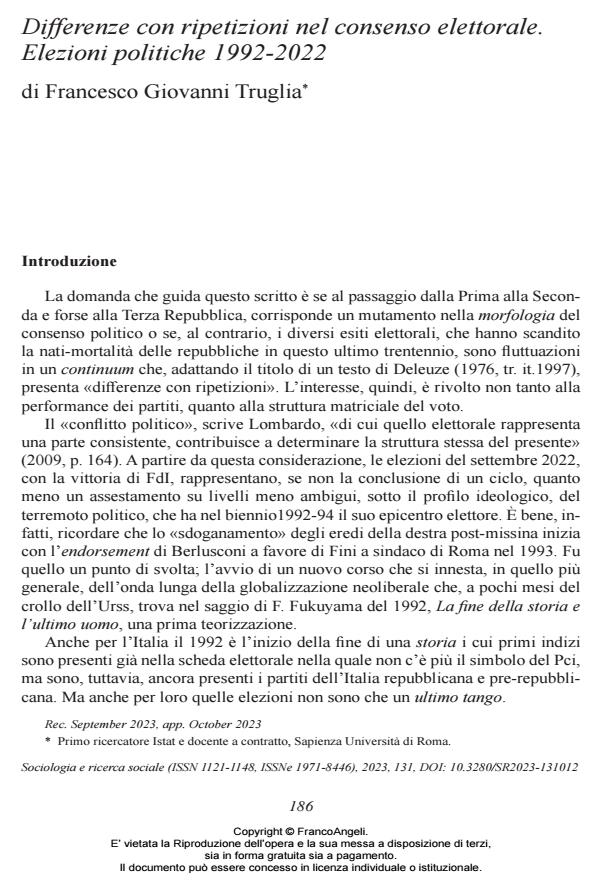Differences with repetitions in electoral consensus. General elections 1992-2022
Journal title SOCIOLOGIA E RICERCA SOCIALE
Author/s Francesco Giovanni Truglia
Publishing Year 2023 Issue 2023/131 Language Italian
Pages 12 P. 186-197 File size 304 KB
DOI 10.3280/SR2023-131012
DOI is like a bar code for intellectual property: to have more infomation
click here
Below, you can see the article first page
If you want to buy this article in PDF format, you can do it, following the instructions to buy download credits

FrancoAngeli is member of Publishers International Linking Association, Inc (PILA), a not-for-profit association which run the CrossRef service enabling links to and from online scholarly content.
The long history of the first Republic concluded in the two-year period 1992- 1994, at least in journalistic parlance. This was the beginning of a new tendency that, at least until now, seems more concerned with the modalities of political communication, aimed primarily at the creation of electoral consensus, than the development of a project of wide-ranging reforms. In this study, since the nine elections that took place between 1992 and 2022, an attempt was made to investigate, in a long-term longitudinal perspective, whether the transition from the first to the second Republic and from this to the third and possibly to the fourth corresponds to a different configuration of elector- al consent. The focus, therefore, is not so much on the results of each election, but on the effects that they have produced, in terms of stability/change, in the matrix structure of the consensus.
- S. Bolasco (1999), Analisi multidimensionale, Carocci, Roma.
- M. Bresciani, G. Schwarz (a c. di) (2021), La democrazia dei populisti tra Europa e Americhe, Viella, Roma.
- M. Cacciari (2020), Il lavoro dello spirito, Adelphi, Milano.
- R. Coppi (1998), Analisi statistica multivariata, Roma, Dip. di Statistica, probabilità e statisti- che applicate, La Sapienza.
- G. Deluze (1976), Différence et repétition, Presses Universitaires de France; tr. it. Differenza e ripetizione, Milano, Raffaello Cortina, 1997.
- R. De Felice (1995), Le interpretazioni del fascismo, Roma-Bari, Laterza.
- L. De Sio (2022), Dietro il successo di Meloni: il nuovo bipolarismo, le strategie giuste e sba- gliate, e il dilemma del PD, https://cise.luiss.it/cise/2022/09/29.
- B. Escofier, J. Pagès (1994), «Multiple Factor Analysis (AfmULT package)», Computational Statistics & Data Analysis, 18, 1, pp. 121-40.
- R. Esposito (1999), Categorie dell’impolitico, Bologna, il Mulino.
- F. Fukuyama (1992), The End of History and the Last Man, New York, The Free Press; tr. it. La fine della storia e l’ultimo uomo, Milano, Rizzoli, 1992.
- P. Ignazi (2018), I partiti in Italia dal 1948 a oggi, Bologna, il Mulino.
- P. Ignazi (2023), «La politica polarizzata», Il Mulino, maggio, -- https://www.rivistailmulino.it/a/ la-politica-polarizzata.
- Istat (2022), Rapporto Sdgs 2022. Informazioni statistiche per l’agenda 2030 in Italia, Roma.
- A. Lepre (1993), Storia della prima Repubblica. L’Italia dal 1942 al 1992, Bologna, il Mulino.
- C. Lombardo (2009), Dalla politica al territorio. Aspetti della competizione elettorale nelle Seconda Repubblica, in M. Morellini, M. Prospero (a c. di), Perché la sinistra ha perso le elezioni?, Roma, Ediesse.
- C. Lombardo, E. Novelli, C. Ruggiero (a c. di) (2019), La società alle urne. Strategie comuni- cative, attori e risultati delle elezioni politiche 2018, Milano, FrancoAngeli.
- T. Mann (1918), Betrachtungen eines Unpolitischen, Berlin, S. Fischer Verlag; tr. it. Conside- razioni di un impolitico, Milano, Adelphi, 1972.
- L. Monti (1999), «Thomas Mann e le “categorie dell’impolitico”», Filosofia politica, 13, 1, pp. 143-56.
- M. Nacci (2009), Storia culturale della, Milano, Bruno Mondadori.
- G. Passarelli, D. Tuorto (2018), La Lega di Salvini. Estrema destra di governo, Bologna, il Mulino.
- V. Pazé (2017), «Il populismo come antitesi della democrazia», Teoria politica, Nuova serie, Annali VII, pp. 111-25.
- M. Prospero (2019), Uno spazio politico a più dimensioni, in C. Lombardo, E. Novelli, C. Rug- giero (a c. di), La società alle urne. Strategie comunicative, attori e risultati delle elezioni politiche 2018, Milano, FrancoAngeli.
- L. Ricolfi, S. Testa (2002), «Il bipolarismo imperfetto. Fra spazio elettorale e spazio morale», Micro & Macro Marketing, 2, pp. 257-80.
- G. Sartori (1982), Teoria dei partiti e caso italiano, Milano, SugarCo.
- C. Schmitt (1963), Theorie des Partisanen. Zwischenbemerkung zum Begriff des Politischen,
- Berlin, Uncker & Humblot; tr. it. La teoria del partigiano, Milano, Adelphi, 2005.
- F.G. Truglia (2014), «L’Italia incantata. Geo-statistica della diffusione dell’astensionismo, ele- zioni politiche 2008 e 2013», Sociologia e ricerca sociale, 34, 101, pp. 61-90.
- L. Zanatta (2004), Il populismo come concetto e categoria storiografica, in A. Giovagnoli, G. del Zanna (a c. di), Il mondo visto dall’Italia, Milano, Guerini e Associati.
Francesco Giovanni Truglia, Differenze con ripetizioni nel consenso elettorale. Elezioni politiche 1992-2022 in "SOCIOLOGIA E RICERCA SOCIALE " 131/2023, pp 186-197, DOI: 10.3280/SR2023-131012